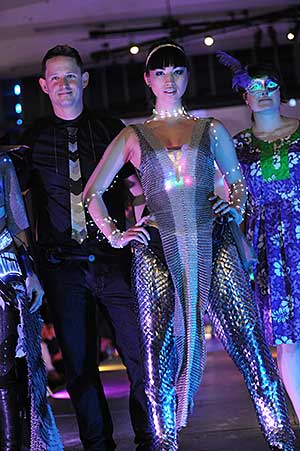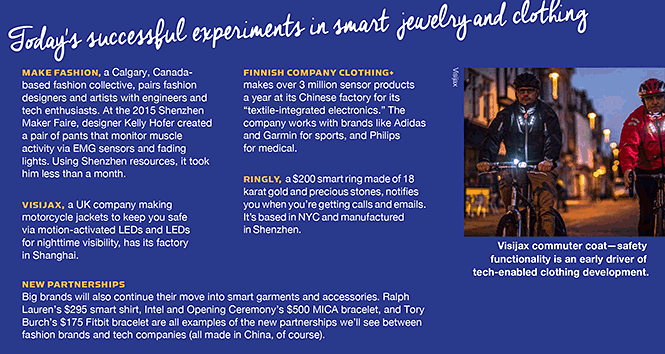Future Now
The IFTF Blog
High Fashion Meets Maker Manufacturing
This story first appeared in the inaugural issue of IFTF's magazine, Future Now.

PERSONAL TECH BECOMES FASHION
Fashion has always been a form of communication and self-expression, a quick visual signal of one’s tastes, allegiances, and socioeconomic position. Over the next decade, personal fashion and personal computing will begin to blur, offering us a new way to think about what today we call “devices.” Whereas today’s personal devices help us communicate primarily through their connection to networks and software, the next generation of devices will allow us to communicate through their form factors as well. The colors, textures, and capacities of clothing, jewelry, and shoes, enhanced with digital powers, will be new modes of communication in and of themselves.
 Today’s wearables are mostly focused inward, on our relationship with ourselves, notes Rachel Hinman, a leading thinker on the intersection of tech and fashion. Health trackers help us understand our bodies in new ways and improve performance; smart clothing lights us up and keeps us safer at night as we ride our bikes, or heats our torso, hands, and feet on a cold day; smart shoes deliver buzzes to point out the right path through a city. But the real promise of smart wearables is precisely what has made mobile phones so powerful: their ability to connect us to others and to share our inner worlds. We’ll need to rethink our technology user interface paradigms, devices, and brands, redesigning them to enable self-expression. There will be a lot to learn from the world of the atelier, with its exquisite attention to the rapid cycles of give-and-take between branded designs and the street.
Today’s wearables are mostly focused inward, on our relationship with ourselves, notes Rachel Hinman, a leading thinker on the intersection of tech and fashion. Health trackers help us understand our bodies in new ways and improve performance; smart clothing lights us up and keeps us safer at night as we ride our bikes, or heats our torso, hands, and feet on a cold day; smart shoes deliver buzzes to point out the right path through a city. But the real promise of smart wearables is precisely what has made mobile phones so powerful: their ability to connect us to others and to share our inner worlds. We’ll need to rethink our technology user interface paradigms, devices, and brands, redesigning them to enable self-expression. There will be a lot to learn from the world of the atelier, with its exquisite attention to the rapid cycles of give-and-take between branded designs and the street.
HOW FASHION AND TECH WILL LOOK MORE ALIKE THAN DIFFERENT
Fashion and technology production cycles have traditionally been at polar ends of the manufacturing and consumption spectrum. Fashion is about originality and change, with studios producing two distinct collections every year. New designs seen on a runway become “fast fashion.” They can be copied, manufactured, and distributed around the world in a matter of weeks. Their low cost and frequent updates drive rapid consumption cycles of “disposable” stylish products. Our personal devices, on the other hand, take years to develop; their “new looks” come out no more than once a year and often contain only the tiniest variations. And they remain among the most expensive personal items we own. With changes in the way that electronics are being developed, however, the world of 2025 is likely to include smart fashion that evolves just as quickly as today’s ordinary clothes and accessories.
It starts with the rise of what IFTF calls “social manufacturing”: the ability of small groups of people to quickly bring an idea to the shelf by using crowdfunding, local maker spaces, online learning resources, and services that link entrepreneurs to design and manufacturing in China. Nowhere has this been more evident than in electronics. Apple and Samsung currently dominate the phone market, but new entrants are popping up daily to create the kinds of edgy, connected accessories that will define the wearable category going forward—products like the Oculus Rift virtual reality headset didn’t come out of corporate R&D labs. While the big companies release smart watches that look more or less like mini computers on your wrist, it will be smaller start-ups, sometimes in partnership with fashion brands, who will build the new world of fashion wearables.
HOW CHINA WILL BECOME A PLATFORM FOR GLOBAL SMART FASHION EXPERIMENTATION
Part of the story of the growing hardware renaissance is that more Western entrepreneurs are going directly to China. For the first time they are able to tap into superfast Chinese design and new smallbatch manufacturing capacities. Perhaps even more importantly, into what inventor/hacker Bunnie Huang calls China’s “network view” of IP and ownership. In the world of hardware start-ups, he writes, “Chinese entrepreneurs [have] had relatively unfettered access to cutting-edge technology, enabling start-ups to innovate while bootstrapping. Meanwhile, Western entrepreneurs often find themselves trapped in a spiderweb of IP frameworks, spending more money on lawyers than on tooling.” Chinese engineers’ access to technology is what allowed them to mix and match, driving the growth of low-end Chinese mobile phones that competed with Apple on the high end, and ultimately destroyed Nokia and Motorola in the space of a few years. Now imagine this applied to the world of smart objects.
 Of course China is not just the world’s largest electronics manufacturer, it is also the world’s largest apparel maker, making over 40% of US apparel imports in 2014. Thus we may see many more experiments that bring together advanced garment manufacturing and personal electronics manufacturing. The wild card in this story is the future of China’s shanzhai, or knock-off manufacturing. These shadow networks copy the latest runway fashions, manufacture them, and quickly distribute them to every major city in the world, to meet the demands of those who want to sync with global fashion trends but can’t afford the steep prices the authentic versions command. Now imagine this applied to the world of smart fashion.
Of course China is not just the world’s largest electronics manufacturer, it is also the world’s largest apparel maker, making over 40% of US apparel imports in 2014. Thus we may see many more experiments that bring together advanced garment manufacturing and personal electronics manufacturing. The wild card in this story is the future of China’s shanzhai, or knock-off manufacturing. These shadow networks copy the latest runway fashions, manufacture them, and quickly distribute them to every major city in the world, to meet the demands of those who want to sync with global fashion trends but can’t afford the steep prices the authentic versions command. Now imagine this applied to the world of smart fashion.
All of this activity will be fueled by China’s own need to innovate, driven by rising wages and slower economic growth. In city halls and corporate boardrooms around the world, economic growth is becoming linked with new strategies to
support creativity and imagination. China is making bold moves in this regard, though it is too early to know exactly how they will play out. Earlier this year the Chinese State Council announced its “mass innovation” policy and Chinese Premier Li Keqiang personally visited a “maker space” in Shenzhen. The government rolled out new supports for entrepreneurs and small businesses, from community workshops, to educational curriculum, to Maker Faire festivals for DIY creators like the one in Shenzhen that drew nearly 300,000 visitors in June 2015.
The city of Shenzhen is leading the way among Chinese cities, with an ambitious International Makers Week and a web of new services and spaces meant to connect entrepreneurs to the vast design and manufacturing resources of the city. Not surprisingly, most of these have focused electronics, and smart manufacturing. But if the city can expand its small-batch manufacturing model to garment manufacturing as well, it may be able to compete with Shanghai and Beijing, China’s fashion leaders, to build a bridge between apparel, electronics and smart clothing. To that end, a new Fashion Technology Industry Accelerator (FTIA) initiative was launched in Shenzhen in June 2015. A partnership between Shenzhen’s Industrial Design Profession Association (SIDA) and the Council of Fashion Designers of Shenzhen, it aims to become the leading “fashion IoT platform in China,” says FTIA co-founder David Chu.
We can already see the outlines of an unprecedented cross-border network of Chinese and Western know-how, capital, and creativity that could fuel innovative smart fashion, IoT, and personal computing products. Local manufacturing efforts such as New York-based Maker’s Row, an online marketplace that connects American manufacturers and entrepreneurs so that they don’t have to go abroad, could begin to play a bigger role in smart fashion experiments. But for the next decade at least, China will remain the go-to source for wearable electronics due to its position as the world’s largest manufacturer of both electronics and garments, and to its dynamic design, materials, and entrepreneurial communities.
 FUTURE NOW—The Complete New Body Language Research Collection
FUTURE NOW—The Complete New Body Language Research Collection
The New Body Language research is collected in its entirety in our inaugural issue of Future Now, IFTF’s new print magazine.
Most pieces in this issue focus on the human side of Human+Machine Symbiosis—how body area networks will augment the intentions and expressions that play out in our everyday lives. Some pieces illuminate the subtle, even invisible technologies that broker our outrageous level of connection—the machines that feed off our passively generated data and varying motivations. Together, they create a portrait of how and why we’ll express ourselves with this new body language in the next decade.
For More Information
For more information on the Tech Futures Lab and our research, contact:
Sean Ness | sness@iftf.org | 650.233.9517




